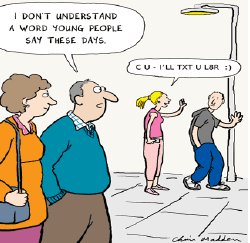Is age the cause of receding gums?
By Claudia Hammond.
The phrase “long in the tooth” comes from the
practice of gauging a horse’s age by the length of its teeth.
Nineteenth century horse-traders were not a particularly
trustworthy bunch, so a wise buyer would often check inside
the animal’s mouth. If the teeth looked long it meant its gums
had already receded, suggesting the potential purchase might
be older than claimed. This might have served people well
when it came to buying horses, but what about humans?
Gingival recession, as it’s formally known, is more
common amongst the elderly. A US study of almost 10,000
people found that 38% of people aged 30-39 had some degree
of the condition, compared with 71% in the 50-59 age group, and 90% for those aged between 80-90. However that doesn’t
mean ageing in itself is the cause. It’s a long process that can
start in your teens, and one that can be triggered by various
factors.
In some cases, there is nothing people can do to
reduce their chances of developing the condition. Some people
inherit thin and fragile gums which recede more easily. Others
have teeth which are overcrowded or stick out, meaning that
there’s not enough jawbone to cover the root of the tooth.
Dental hygiene also plays a big role. Plaque,
consisting of a sticky film of bacteria, is constantly forming on
our teeth. Failure to clear the build ups through brushing and
flossing can lead to gum disease. If left untreated, one possible
complication is the destruction of the bone around the teeth
and the gum tissue in which they sit. As the tissue recedes, the
root of the tooth is exposed, making it appear longer.
Then there’s the way you brush your teeth. If you use
a sawing action with a hard brush, there’s a danger of
gradually wearing away the gum. For this reason dentists tend
to advise brushing in small circles with a soft brush or using an
electric toothbrush to prevent you from pressing so hard. The
damage accumulates over time, causing the gums to recede
imperceptibly, until one day you look in the mirror and realise
you’ve changed. As this transformation can take decades,
many people assume it’s a natural part of the ageing process.
Research on receding gums often relies on asking
people what kind of toothbrush they use, the brushing motions
they use and how hard they brush. Some argue that due to a
lack of controlled studies, there’s no definitive evidence that
hard brushing does anything more than cause temporary
abrasions, but many dentists do consider there to be a link.
The condition is also more common in smokers.
With so many different factors involved, controlled
studies are difficult to do. Many are cross-sectional, meaning
they take a snapshot in time.
So if you’re looking to buy a horse it might be worth
their checking their teeth, but ageing is not a direct cause of
receding gums. It’s simply that the damage accumulates and
becomes more obvious over time.
Source: http://www.bbc.com (Adapted)
According to the text, judge the items below as true (T) or
false (F).
I. Nineteenth century horse-traders were reliable people.
II. A buyer who would check the horse's gums before buying it,
was not considered a clever person.
III. Although it is more observed amongst the elderly, gingival
recession can begin during youth.
IV. The phrase “long in the tooth” is related to the practice of
determining a horse's age, and therefore its value, by
examining its teeth.
V. People can always prevent the development of gingival
recession, once it is never possible for them to inherited
sensitive gums.
Mark the correct option:


